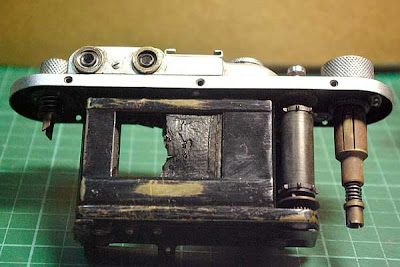An Easy, Do-It-Yourself, Fall-proof (almost), Non-Wobbling, Takeup Spool for the Kiev Rangefinder Cameras 

Many Kiev RF are found without takeup spools These cameras (except models "5" and "4M/4aM" with fixed takeups) were designed to accept either cassette to cassette loading or else an accessory removable takeup. Being removable makes this spool easy to lose. The usual DIY spools use the discarded spools from standard 35mm film cassettes. The usual design calls for a slit of some sort, to catch the film leader tip, to be cut diagonally into the spool spindle. Kodak cassettes, with solid spool cores are often used. Spools from Fuji and others have split cores (with hooks to catch the end of the film) are not often recommended. Using the 35mm spool as is makes them wobbly and loose. They will fall out easily (that's why the second step in Contax/Kiev loading is to hit the floor, crouch on all fours, and look for the wayward spool!  ).
).
 ).
).This design uses 35mm spools too. But unlike the usual DIY's, this modified spool does not fall out easily. The key here is to use the cassette's metal caps. Sticking these to the plastic spool's ends makes the flanges wider. The idea behind this is that the takeup side was designed to accommodate a 35mm cassette- so making the takeup spool as wide as the cassette would make it fit nicely without wobbling. 

Wider flanges will keep the spools from falling out. The flanges will be retained by the spring flanges on the camera's film chambers. Wider flanges also prevent the spools from wobbling, and make locking the camera's back easier. 

The first step is to cut a lengthwise (not angled) slot on the spool shaft. A copping-saw blade (with its ends snapped off) will fit through the central slot. Cut all the way to the spool's flange. This will be the slot which will hold the film.

Apply rubber contact cement ("Rugby") on the spool's flanges and the cassette metal caps. Use 'snap cap' cassettes, rather than the crimped ones. Metal flanges from crimped cassettes usually become warped and distorted when removed from the cassette shell. When the rubber cement becomes tacky dry, stick the metal caps and hammer a bit for a firm fit. Once stuck, they will be almost impossible to remove.
The spool in action. That's all that is to it!.
*Compatible with Contax RF too.











